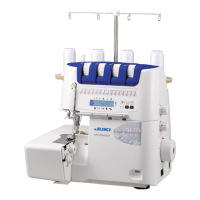12
Needles
Needles must be in perfect condition.
Problems can occur if needles:
A are bent.
B are damaged or blunt.
C have hooked points.
Needle and thread
The needle size used depends on the thread. The needles should be in accordance with thread used.
When sewing, the thread is fed through the long groove in the needle. If the needle is too ne, the thread
does not t into the groove and stitches will be skipped.
Use needles No. 70 - 90.
* It is recommended to use JLx2 needle, especially when sewing thick materials, overlapped section, etc,
with overlock machine.
Thread/decorative threads
Sewing and special overlock threads are manufactured in a wide variety of types, weights and combination
of bres. It is worth investing in good quality threads for perfect sewing results. Decorative threads specially
made for overlockers (available on cones) are also becoming widely available. We recommend following the
basic guidelines when using special threads on your overlocker:
- Purchase threads on cones or spools which are produced exclusively for overlocking.
- When using normal spools, use the spool caps (in accessory bag).
- Only use decorative threads in the loopers. The thread must move easily and without resistance through
the thread guides and looper eyes.
- The thicker the thread, the longer the stitch length (3-4).
- The thicker the thread, the looser the tensions.
- Sew slowly when using decorative threads. Pull the thread chain gently to the rear when starting to sew.
Always test sew decorative threads before starting to sew your work.
Needle and thread
A
B
C
Thread, needle, application table
Thread Needles Where Application
All purpose overlock thread 120/2
(polyester)
70-90
Needles and looper
threads
For all overlock.
Polyester-continuous laments Loopers only Neatening edges
Woolly nylon Loopers only Soft seams in knits, rolled hems.
Spun Polyester 80-90
Needles and looper
threads
Seams in all fabrics.
Embroidery/darning and decorative
threads
70-90 Loopers only Neatening edges, rolled hems.

